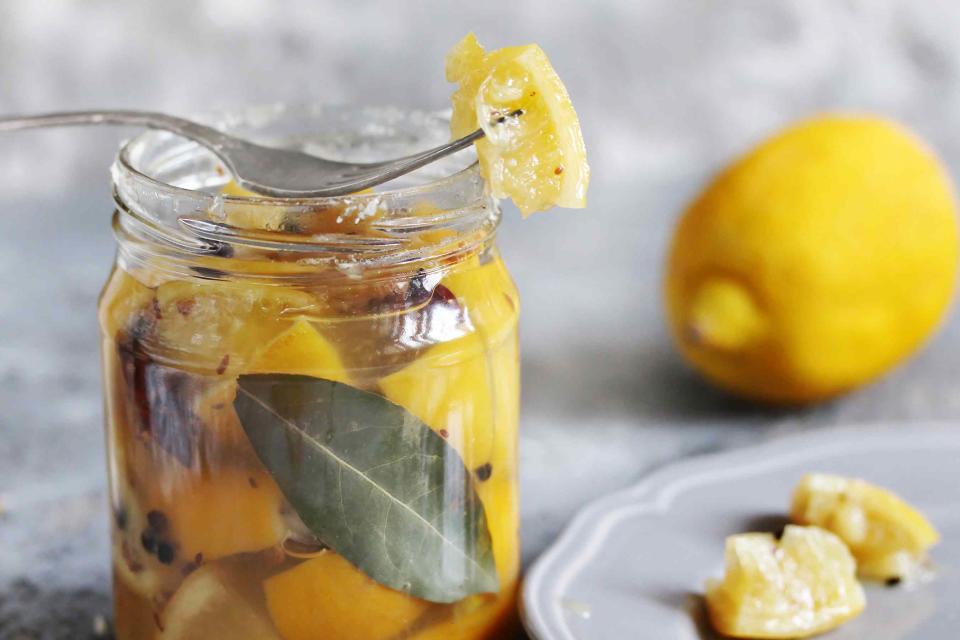Preserved Lemons Make Everything Better — Here’s How to Cook With Them
Add a dose of salty, tart umami to everything from soup to salad dressing with one of our favorite fermented ingredients.

Lyudmila Mikhailovskaya / Shutterstock
Trying to step up your cooking game with no extra fuss? Reach for a jar of preserved lemons. Preserved lemons are one of our favorite ways to cook and eat better, not to mention enjoy more out of lemons. Grab a jar, water, and salt and you can give your cooking a pop of acidity and salty goodness.
What are preserved lemons?
Preserved lemons trace their origins to North Africa; they’re a key ingredient in Moroccan and other North African cuisines as well those across the Middle East and the Mediterranean. To make them, lemons are quartered lengthwise three-quarters of the way down, then packed in kosher salt between each piece. They are tightly packed in a jar, and then brined in a solution of lemon juice and salt water, plus aromatics like peppercorns or cinnamon sticks. The lemons need to sit in the brine for at least three weeks before they are used. During this process, the lemons ferment. Fermentation enhances the aroma of the lemon peel, tempers the lemons’ sharp acidity, and softens the rind, transforming fresh lemon into a potent ingredient with a complex salty, sour, and umami-rich flavor. Once opened, a jar of preserved lemons will keep (if stored correctly in the refrigerator) up to a year. Unlike other fermented foods like kimchi or other pickles, preserved lemons aren’t meant to be eaten alone. Instead they are used to season dishes, where they deliver a layered dose of salt, acid, and umami.
Do you use the rind, the pulp, or both?
Since preserved lemons are brined in salt, giving them a quick rinse before using them is a sound way to remove any excess saltiness. The rinsed lemons will still be quite salty; you aren’t losing out on any of their flavor by rinsing them.
It is possible to use both the rind and the pulp together in dishes like this Chicken Tagine, or this Roasted Carrot Salad. The rind and pulp can also be blended in a food processor together (remove the seeds first) to create a punchy preserved lemon paste that can be added directly into sauces, vinaigrettes, batters, marinades, dips, and cocktails. But if you’re new to cooking with preserved lemons and still getting to know the strength of their flavor, it’s best to use the rind and pulp separately.
The peel and rind are where the most concentrated, citrusy flavor is. After separating it from the pulp, the peel should be finely sliced, minced or chopped.
While many recipes advise discarding the pulp, you can use the pulp. It is quite salty, so add preserved lemon pulp to a dish slowly, as you would salt, and taste as you go. One way to make use of preserved lemon pulp is to finely chop it and push it through a strainer with a rubber spatula, and use the flavorful, fermented juices to boost dressing and marinades. Another method is to mash the pulp directly into a dish. This works best with low-and-slow recipes such as soups and stews, where the long cook time tames the pulp’s pungency.
How to cook with preserved lemons
The most straightforward introduction to using preserved lemons is to add the finely minced peel to dressings and vinaigrettes. You can also bump up the salinity of a vinaigrette for salad (or for a quick roasted fish), or add a citrus note to an aioli, chimichurri, or pesto by adding a teaspoon or two of finely minced preserved lemon. Use preserved lemon peel to boost a side of green beans or make a preserved lemon yogurt as a sauce for simply roasted broccoli. The finely minced peel is also a terrific toast-topper
Preserved lemons can take a main course dish from delicious to magical. Thinly sliced or finely minced, the peel of preserved lemons punches up tagines and stews, slow-cooked beans, roasted vegetables and main-course salads. Proteins with higher saturated fat content in particular benefit from larger pieces of preserved lemon to help counter their richness and lift up their overall flavor. (These grilled lamb ribs call for quick preserved lemons, but you can also use store-bought).
Where to buy preserved lemons
You can find a variety of preserved lemons from brands such as Mina and Casablanca Market at grocery stores. Many online retailers also can send preserved lemons through the mail; try Le Bon Magot, Kalustyan’s, Thrive Market, and The Milk Street Store.

